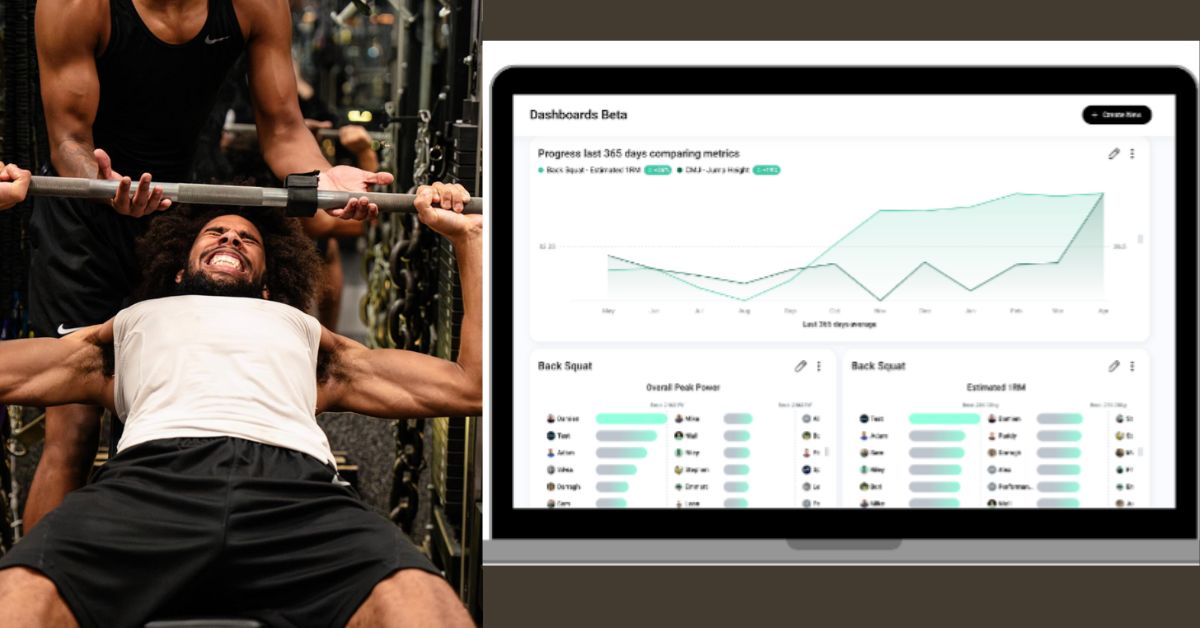As the Director of Strength & Conditioning for the Colorado Men’s Basketball and Olympic Sports teams, my priority is to create an elite training environment where athletes can perform at their best. This requires a strategic approach that balances workload, readiness, and individualized programming. Over the years, I have tested numerous technologies, but often felt there are trade-offs between efficient weight room flow and useful/accurate tech.
In this playbook, I will break down four key training protocols and philosophies that drive our success:
- Velocity-Based Training (VBT).
- Readiness monitoring.
- Return-to-play markers.
- Driving intent and competition in the weight room.
I will also summarize how the Output Sports system helps us achieve a unique balance of accuracy and efficiency in each these areas while also be simple enough for our athletes to run themselves. Output is and end-to-end system for strength coaches which utilizes a single wireless, portable sensor for athletic testing and VBT, a mobile/tablet capture app that directs S&C sessions and drives athlete intent, and a centralized coaches’ hub for leaderboards, analytics and building and managing athlete workouts. We chose Output because it provides a unique blend of versatility, simplicity, efficiency, and affordability for weight-room technology and it prevents the age-old issue of needing a whole suite of technology to drive a data-driven S&C session.
We chose Output because it provides a unique blend of versatility, simplicity, efficiency, and affordability for weight-room technology and it prevents the age-old issue of needing a whole suite of tech to drive a data-driven S&C… Share on X1. Velocity-Based Training (VBT): Enhancing Precision in Strength Development
Why & What: VBT is essential for modern strength training because it provides real-time adjustments based on an athlete’s actual performance rather than relying on estimated percentages of one-rep max. It also helps drive intent to maximize athlete adaptation. This approach ensures that training loads align with an athlete’s daily physiological state, optimizing gains while reducing unnecessary fatigue.
This is especially important given our athletes’ busy game and travel schedule at Colorado. By utilizing bar speed as a performance indicator, VBT helps prevent overtraining, facilitates progressive overload, and allows for dynamic adjustments based on fatigue levels. Unlike traditional fixed-percentage training, which may not account for day-to-day variability, VBT ensures that every set is performed at the optimal intensity.
By utilizing bar speed as a performance indicator, VBT helps prevent overtraining, facilitates progressive overload, and allows for dynamic adjustments based on fatigue levels. Share on X
Furthermore, VBT helps in power development, particularly for explosive sports like basketball and track, where speed of movement is just as critical as strength. Training at specific velocity zones enhances neuromuscular efficiency, ensuring that athletes produce maximum force at game-speed movements.
How Output Helps:
- Provides real-time feedback on bar speed and power output, enabling athletes to adjust loads instantly whether we are on the road or at home in our weight-room.
- The athletes view their VBT workouts in the app and seamlessly follow their guidelines for the day.
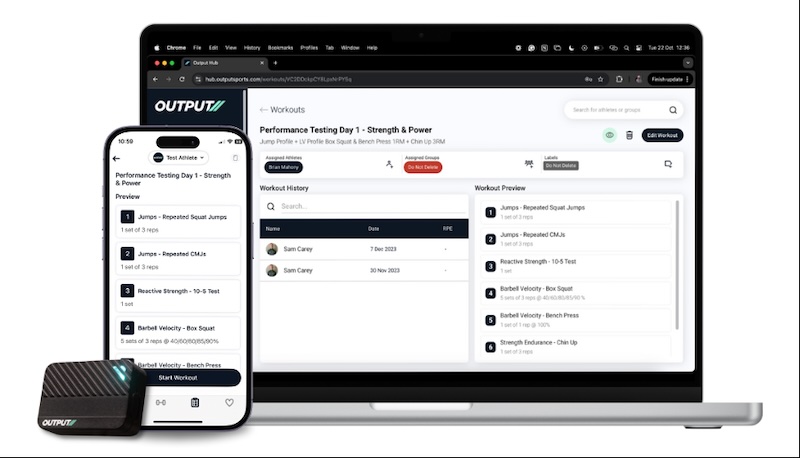
2. Readiness Monitoring: Knowing When to Go and When to Slow
Why & What: Athlete readiness is a cornerstone of effective training and injury prevention. Each athlete responds differently to stressors such as high training loads, travel, and competition. Monitoring daily readiness ensures that we adjust workloads accordingly, aiming to reduce the risk of injury and maximizing performance. When readiness is overlooked, athletes may train too hard when fatigued, leading to poor adaptations, decreased power output, and increased susceptibility to overuse injuries.
When readiness is overlooked, athletes may train too hard when fatigued, leading to poor adaptations, decreased power output, and increased susceptibility to overuse injuries. Share on XReadiness testing evaluates neuromuscular and physiological markers such as jump height deficits, mobility restrictions, and reactive strength. This is particularly crucial in team sports like basketball where external stressors, including travel and game schedules, significantly impact performance. By tracking trends over time, we gain insights into how individual athletes respond to various stimuli, enabling us to optimize recovery protocols and make informed decisions on training loads.
How Output Helps:
- Measures jump tests, RSI, and mobility to assess neuromuscular fatigue.
- Customizable ‘traffic-light’ dashboards for any combination of surveys and measures that fit our training use-case. These also allow you to set custom thresholds for when to flag a measure that is in the red or green.
- Integrates with wellness surveys to provide a holistic readiness profile.
- Allows remote monitoring for athletes away from campus.
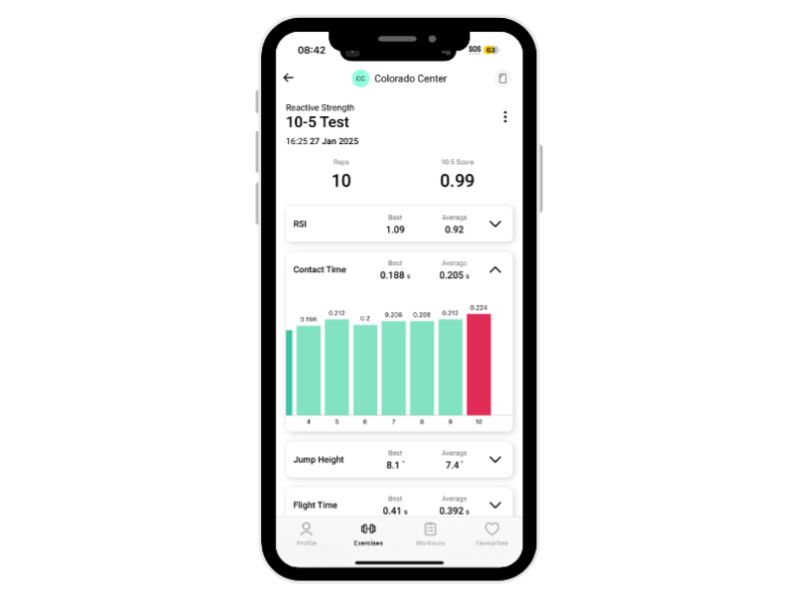
3. Return-to-Play: Data-Driven Rehab and Recovery
Why & What: The return-to-play process must be carefully structured to ensure full recovery while minimizing re-injury risk. Subjective assessments alone can lead to premature return, increasing the likelihood of setbacks. Objective data allows practitioners to track progress and make evidence-based decisions about an athlete’s readiness for return.
Rehabilitation should focus on restoring full function, not just reducing pain. This means systematically rebuilding strength, mobility, and power while addressing movement compensations that could have developed post-injury. By comparing pre-injury baseline data with recovery progress, we can ensure that an athlete’s movement mechanics, strength levels, and explosive capabilities are fully restored before they return to competition.
By comparing pre-injury baseline data with recovery progress, we can ensure that an athlete’s movement mechanics, strength levels, and explosive capabilities are fully restored before they return to competition. Share on XAn effective return-to-play protocol also considers asymmetries between limbs, which can lead to compensatory patterns and increased injury risk. By tracking these metrics, strength coaches and medical staff can implement targeted interventions to correct imbalances before the athlete is cleared for competition.
How Output Helps:
- Provides objective movement data to track rehab progress and ensure progression. This includes early-stage markers like balance and mobility and late-stage markers like single limb power and reactive strength.
- The Output Hub enables us to create rehab dashboards that show key targets, any asymmetries of significance, and engage the athletes in the benefits of their rehab exercise.
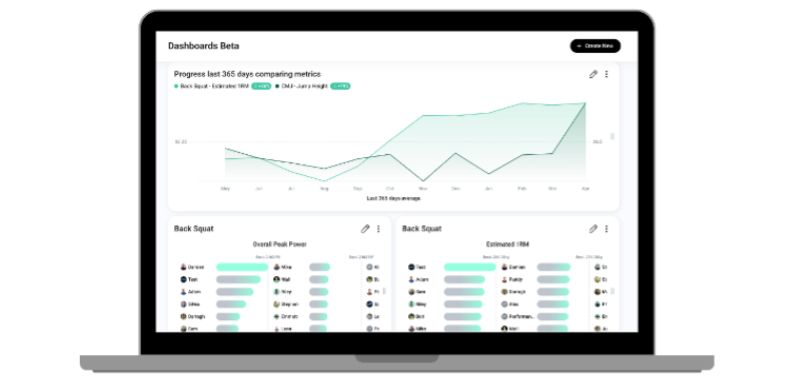
4. Driving Intent: Fostering Competition and Engagement
Why & What: Athletes perform best when they are fully engaged and motivated. Training should not only develop physical attributes, but also cultivate a high-performance mindset. Creating an environment where athletes push themselves fosters long-term development, resilience, and competitiveness.
A key factor in driving intent is providing immediate and meaningful feedback. When athletes see real-time performance data, they develop a stronger connection between effort and outcome. Leaderboards, benchmarks, and peer competition reinforce this culture, ensuring that each training session is executed with purpose.
A key factor in driving intent is providing immediate and meaningful feedback. When athletes see real-time performance data, they develop a stronger connection between effort and outcome. Share on XWhile leaderboards and intent have long been a focus in weight rooms for compound lifts like back squat and bench press, we implement competition across the whole force-velocity spectrum including plyometrics, med ball work, kettlebell movements and ‘traditional’ VBT exercises.
How Output Helps:
- Displays real-time leaderboards to enhance competition. These can be updated in an instant to a new metric and exercise.
- Relative leaderboard option enables people to rank versus their percentage of their own personal best—this creates competition across all athletes and the chance for anyone to top the leaderboard.
- Versatile measurement of movements where max intent is essential (e.g., med balls, plyometrics).
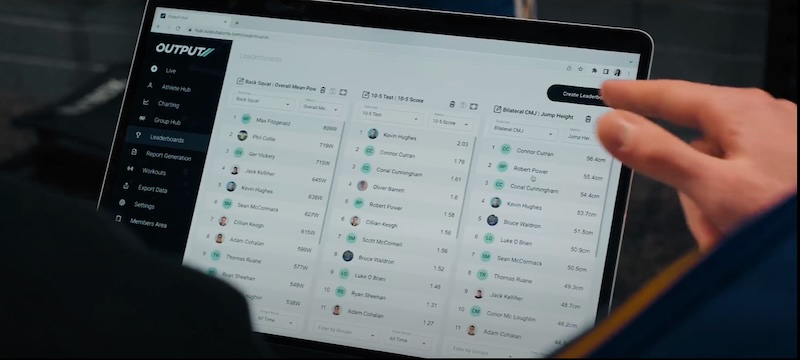
Final Thoughts: A System That Elevates Performance
By embracing real-time feedback, seamless integration, and objective decision-making, coaches can unlock their athletes’ full potential while fostering a competitive and efficient training environment.
Output Sports has become an integral part of our training programme and philosophy. It isn’t just a tracking device—it’s a performance optimization tool that bridges the gap between coaching intuition and data-driven programming. By implementing Output Sports into our VBT, readiness, return-to-play, and athlete engagement strategies, we maximize every session in the weight room without the traditional complexities of multiple technologies.
While there can be a stifling amount of weight-room tech options on the market right now, if you prioritize intent in your athletes’ training, simplicity and efficiency in analysis and intervention, and don’t want to spend a crazy budget, I highly recommend trying Output for your program!

